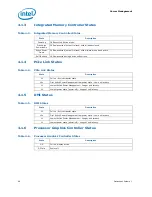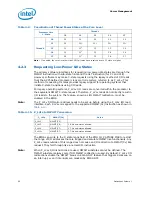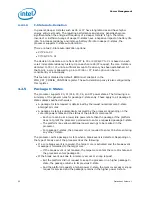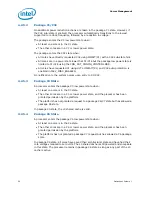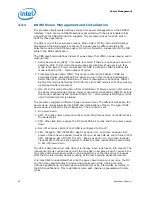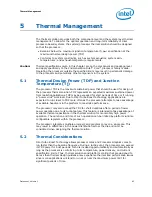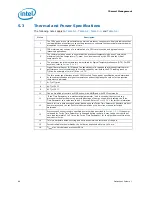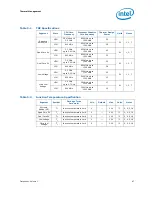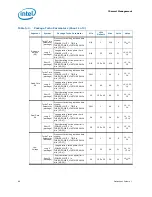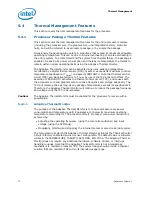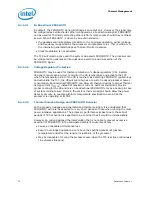
Datasheet, Volume 1
59
Power Management
4.6
Graphics Power Management
4.6.1
Intel
®
Rapid Memory Power Management (RMPM) (also
know as CxSR)
The Intel
®
Rapid Memory Power Management puts rows of memory into self refresh
mode during C3/C6/C7 to allow the system to remain in the lower power states longer.
Mobile processors routinely save power during runtime conditions by entering the C3,
C6, or C7 state. Intel
®
RMPM is an indirect method of power saving that can have a
significant effect on the system as a whole.
4.6.2
Intel
®
Graphics Performance Modulation
Technology(GPMT)
Intel
®
Graphics Power Modulation Technology (Intel GPMT) is a method for saving
power in the graphics adapter while continuing to display and process data in the
adapter. This method will switch the render frequency and/or render voltage
dynamically between higher and lower power states supported on the platform based
on render engine workload. When the system is running in battery mode, and if the end
user launches applications such as 3D or Video, the graphics software may switch the
render frequency dynamically between higher and lower power/performance states
depending on the render engine workload.
In products where Intel
®
Graphics Dynamic Frequency (also known as Turbo Boost
Technology) is supported and enabled, the functionality of Intel
®
GPMT will be
maintained by Intel
®
Graphics Dynamic Frequency (also known as Turbo Boost
Technology).
4.6.3
Graphics Render C-State
Render C-State (RC6) is a technique designed to optimize the average power to the
graphics render engine during times of idleness of the render engine. Render C-state is
entered when the graphics render engine, blitter engine and the video engine have no
workload being currently worked on and no outstanding graphics memory transactions.
When the idleness condition is met, the Processor Graphics will program the VR into a
low voltage state (0-~0.4 V) through the SVID bus.
4.6.4
Intel
®
Smart 2D Display Technology (Intel
®
S2DDT)
Intel S2DDT reduces display refresh memory traffic by reducing memory reads
required for display refresh. Power consumption is reduced by less accesses to the IMC.
S2DDT is only enabled in single pipe mode.
Intel S2DDT is most effective with:
• Display images well suited to compression, such as text windows, slide shows, and
so on. Poor examples are 3D games.
• Static screens such as screens with significant portions of the background showing
2D applications, processor benchmarks, and so on, or conditions when the
processor is idle. Poor examples are full-screen 3D games and benchmarks that flip
the display image at or near display refresh rates.


